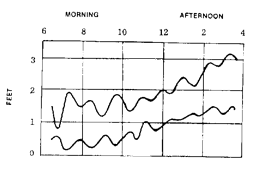 |
Science Frontiers ONLINE No. 88: Jul-Aug 1993 |
|
|
Seashore Seiches
At many spots around the world, sealevel rises and falls with periods of only a few minutes -- much shorter than the common semidiurnal tides and much longer than wind-generated waves. These oscillations of the water surface are termed "seiches." Two fundamentally different kinds of seiches have been noted in the recent literature. The first variety is transitory and can be set into motion by weather disturbances and earthquakes. The second is permanent and a bit more mysterious. Let's take transitory seiches first
September 17, 1992. Anglesey, England. At about 0700 in the morning:
"I was on the beach at Trearddur on western Anglesey, when an acquaintance drove down the beach towing a fishing boat. He launched the boat in about six inches of water and we then engaged in conversation for a couple of minutes. Turning to the boat, we were amazed to find that it was high and dry about 20 metres from the water's edge. Small flatfish, mainly immature brill, could be seen stranded and flapping in the wet sand. About a minute later, the sea started to return and quickly rose up the beach beyond where the boat had originally been launched. An hour later, the oscillation in sea level was still taking place. I determined that the period was just over three minutes and the amplitude just under one metre, the latter measured with reference to a half-submerged rock. At the time of the event, it was just after low water, there were no wind waves or ground swell, and the sea had a glassy appearance."
(Kemp, A.K.; "Anglesey Seiche," Marine Observer, 63: 90, 1993.)
 Short-period oscillations in tidal records at Puerto Princesa, Palawan, the Philippines |
studies of the Puerto Princesa seiches show that the amplitudes of the seiches are greatest every two weeks, indicating they are tied to the astronomical tides. However, they lag the lunar tide by a couple of days. Geophysicists now look to Pearl Bank in the Sulu Sea, some 450 kilometers southeast of Puerto Princesa, where they believe tidal currents create "internal waves" as they hit the shallow bank. These internal waves travel beneath the surface at speeds of only about 8 kilometers/hour, taking about 2� days to reach Puerto Princesa. Here, they surge against the land, causing the observed seiches.
(Giese, Graham S., and Chapman, David C.; "Coastal Seiches," Oceanus, 36:38, Spring 1993.)
Reference. Our catalog Earthquakes, Tides, Unidentified Sounds contains an entire chapter on anomalous wave phenomena. To order, visit: here.